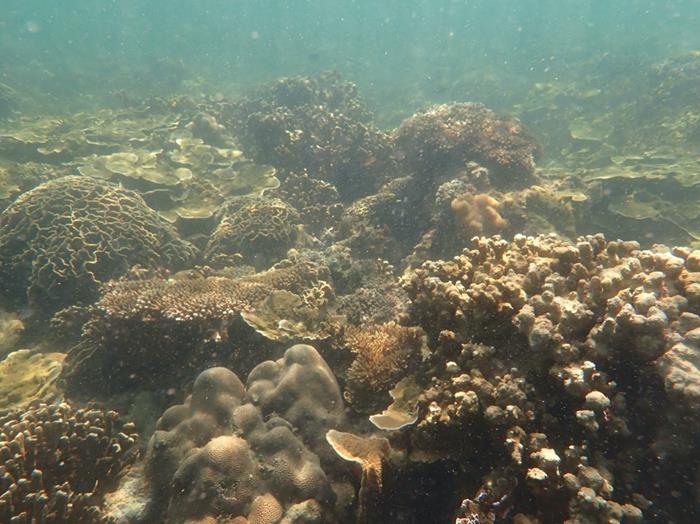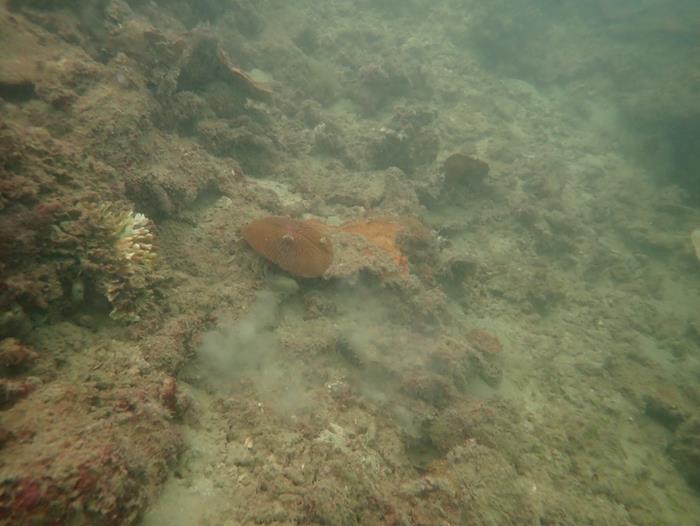Coral reefs are marine ecosystems that support enormous biodiversity.
Coral reefs typically grow in warm and clear tropical oceans. These shallow seas are full of sunlight which corals utilise for photosynthesis with the help of symbiotic algae (Zooxanthellae sp.) that live inside the coral tissue.

Shallow-water coral communities in Singapore. These habitats offer greater amounts of sunlight and the strong tidal currents remove excess sediments (Source: Kyle Morgan/Earth Observatory of Singapore)
Although this is the case for many of the world’s reef systems, there is a growing recognition of coral communities that have adapted to tolerate extreme environments, such as high sedimentation and turbidity (cloudy water conditions). The availability of sunlight on these reefs is very low even at shallow depths.
Poor visibility underwater also makes studying these coral reefs difficult. Our understanding of turbid reefs is oversimplified because of insufficient field data. However, these reefs warrant more exploration as they are not only common in Southeast Asia, but also vulnerable to human stressors because of their proximity to the coast.
Turbid coral reefs experience a process called vertical reef compression, where corals are squeezed into a narrow band of shallow surface waters. This is a consequence of naturally elevated turbidity but can be intensified by human activities that increase sediment inputs into marine environments.
As the impacts of global climate change, such as sea-level rise, begin to be felt across Southeast Asia, there is concern that the effects of poor coastal water quality from coastal urbanisation will be magnified.
An animation of vertical reef compression on turbid reefs under changing environmental conditions (Source: Nguyen Thi Nam Phuong/ Earth Observatory of Singapore)
To understand the causative processes of vertical reef compression we measured various environmental parameters known to influence coral growth using an array of oceanographic equipment. The equipment was deployed for one month on shallow and deep coral reef habitats at Kusu Island and Pulau Hantu in southern Singapore.
Our findings, published in Frontiers in Marine Science, show that Singapore’s coral reefs are very low-light environments. Corals are restricted to approximately eight metres in depth, after which, light levels are too low to support coral growth. Strong tidal currents across shallow habitats maintain healthy corals by removing excess sedimentation. However, fine silt is moved onto reef slopes and harms corals lower down.

Corals on the reef slope received lower sunlight and higher sedimentation of fine silt (Source: Kyle Morgan/Earth Observatory of Singapore)
We show that vertical reef compression is driven from the bottom upwards as the photic zone – the uppermost layer of the ocean that receives sunlight – contracts and fine silts accumulate at depth. In the future, even minor increases in suspended sediment could remove more light and shallow the depth of light penetration further.
Future sea-level rise could decrease the depth of coral growth on Singapore’s reefs by 8 to 12 per cent. A more dramatic compression of coral habitats could occur if water quality continues to decline alongside climate change.
While our research demonstrates the vulnerability of turbid reefs to the effects of local human activities and climate-related impacts, it highlights the need to take steps to reduce local stressors within coastal areas to safeguard coral reef ecosystems.
This study is supported by the AXA Research Fund, Marine Science Research and Development Programme, NTU Presidential Postdoctoral Fellowship and NParks.